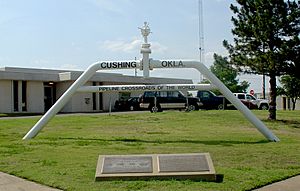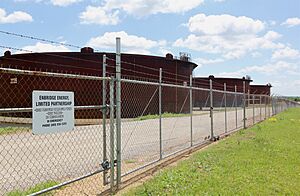Cushing, Oklahoma facts for kids
Quick facts for kids
Cushing, Oklahoma
Koshineki
|
|
|---|---|

Pipeline Crossroads of the World monument (2006)
|
|
| Nickname(s):
"Pipeline Crossroads of the World"
|
|

Location within Payne County and Oklahoma
|
|
| Country | United States |
| State | Oklahoma |
| County | Payne |
| Area | |
| • Total | 7.60 sq mi (19.69 km2) |
| • Land | 7.59 sq mi (19.67 km2) |
| • Water | 0.01 sq mi (0.02 km2) |
| Elevation | 922 ft (281 m) |
| Population
(2020)
|
|
| • Total | 8,327 |
| • Density | 1,096.38/sq mi (423.32/km2) |
| Time zone | UTC-6 (CST) |
| • Summer (DST) | UTC-5 (CDT) |
| ZIP code |
74023
|
| Area code | 539/918 |
| FIPS code | 40-18850 |
| GNIS feature ID | 2410279 |
Cushing is a city in Payne County, Oklahoma, United States. Its name comes from Marshall Cushing, who was a private secretary to a U.S. Postmaster General. The city's population was 8,327 in 2020.
Cushing is sometimes called the "Pipeline Crossroads of the World." This is because it became a major center for trading and storing crude oil after an oil boom in 1912. Many pipelines meet here, making it a very important spot for the oil industry.
Contents
History of Cushing
The land where Cushing now stands was once part of the Sac and Fox Reservation. After the Land Run of 1891, a man named Billy Rae Little built a house and started planning the town. Cushing got its own post office on November 10, 1891.
Trains started coming to Cushing in the early 1900s. The Eastern Oklahoma Railway arrived in 1902, and the Missouri, Kansas and Texas Railway followed in 1903. These railways helped the town grow.
The Oil Boom Era
A big change happened on March 17, 1912. A "wildcatter" (someone who drills for oil in new areas) named Thomas B. Slick found a huge amount of oil east of Cushing. This discovery started an "oil boom." Soon, many more oil wells were drilled, and the area became known as the Cushing-Drumright Oil Field.
Cushing quickly became a hub for finding and producing oil. It also became a place where oil was refined. The Consumers Oil Company opened a refinery in 1913. At one point, more than 50 oil refineries operated in the Cushing area. This is how Cushing earned its nickname, "the pipeline crossroads of the world."
The oil boom didn't last forever. Oil production was highest in 1915 but dropped by half in 1916. As the oil fields produced less, refining became less important. The last two refineries in Cushing closed in the 1970s and 1980s. Train service also ended in 1982.
Cushing's Modern Oil Role
Even after the refineries closed, Cushing kept a valuable asset: the Shell pipeline terminal. This terminal had 39 large storage tanks and pipelines that could move a lot of oil every day. This helped Cushing keep its important role as the "Pipeline Crossroads of the World."
Because of its many pipelines and storage tanks, Cushing was chosen in 1983 as the official delivery point for a major oil trading contract on the New York Mercantile Exchange (NYMEX). This means that when people buy and sell certain types of crude oil, Cushing is where the oil is physically delivered.
In May 2023, there was exciting news for Cushing. A new, very modern oil refinery is planned for the city. It will cost over $5 billion and will be able to process 250,000 barrels of oil each day. This new refinery aims to have a "zero-carbon footprint" and should start working by 2027. It is expected to create many jobs and boost the local economy.
Geography and Climate
Cushing is located in Payne County. It sits where two main roads, Oklahoma State Highway 18 and Oklahoma State Highway 33, cross.
The city covers about 7.6 square miles (19.69 square kilometers) of land. Only a very small part is water.
Cushing experiences a range of temperatures throughout the year. Summers can be very hot, with record highs over 100 degrees Fahrenheit (38 degrees Celsius). Winters can be cold, with temperatures sometimes dropping below zero degrees Fahrenheit (-18 degrees Celsius). The city gets a good amount of rain, especially in spring and early summer.
Population and People
In 2020, Cushing had a population of 8,327 people. The city is home to a diverse group of residents. Most people are White, but there are also significant populations of African American and Native American residents.
Economy and Oil Industry

Cushing is a very important place for the crude oil industry in the United States and worldwide. It's a key spot where many pipelines meet, and it has huge storage facilities. Oil flows into Cushing from all directions and then moves out through many pipelines to different places.
The oil storage tanks around Cushing can hold over 90 million barrels of crude oil. This massive storage capacity makes Cushing a central point for oil trading and distribution. The new refinery planned for 2027 is expected to bring many jobs and a large economic boost to the area.
Sports in Cushing
Cushing has a history with minor league baseball. Teams like the Cushing Oilers and the Cushing Refiners played here in the 1920s. A famous baseball player, Carl Hubbell, even started his professional career with the Cushing Refiners in 1923.
Parks and Recreation
Cushing has several great places for fun and relaxation.
- Cushing Municipal Park: This park started in 1935 and has grown a lot. It features a Duck Pond, picnic areas, playgrounds, a skate park, and a disc golf course.
- Cushing Aquatic Center: This is a fun place to cool off, with a splashpad, a wading pool, a full-sized swimming pool, and several water slides.
- Downtown Cushing Centennial Park: Located on Main Street, this park has a stage and picnic tables, perfect for community events.
- Buffalo Rock Golf and Venue Golf Course: Originally the Cushing Country Club from 1921, this 18-hole golf course is open to everyone.
- Cushing Lake: About 6 miles west of the city, this lake offers a boat ramp, a dock, and a picnic area for outdoor activities.
Education in Cushing
The Cushing school district serves about 1,800 students. It has five schools: a preschool, two elementary schools, a middle school, and a high school.
Transportation
Cushing is easy to reach by road, located at the intersection of State Highway 33 and State Highway 18.
The city also has its own airport, the Cushing Municipal Airport. For bigger flights, people can use the Stillwater Regional Airport (about 20 miles away) or the Tulsa International Airport (about 59 miles away).
Historic Sites
Several buildings in Cushing are listed on the National Register of Historic Places. This means they are important historical sites. Some of these include:
- The Bassett House
- Luke D. Berry House
- Cushing American Legion Building
- Cushing Armory
- Gillespie Drilling Company Building
- Christian K. Usher Luston House
Notable People from Cushing
Many interesting people have come from Cushing, including:
- Paul Blair, a professional baseball player
- Kelly Cook, a former professional football player
- Harold DeMarsh, an early college wrestling champion
- Brian Kelly, a professional boxer
- Frank Lewis, an Olympic gold medalist in wrestling
- Robert Pearce, another Olympic gold medalist in wrestling
- Jay Rubenstein, a well-known historian
- Bob Shirley, a former professional baseball pitcher
See also
 In Spanish: Cushing (Oklahoma) para niños
In Spanish: Cushing (Oklahoma) para niños

